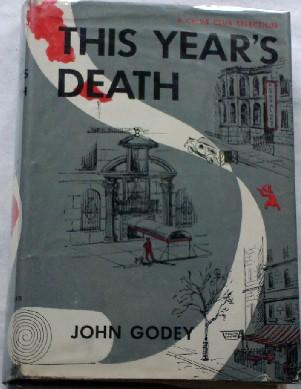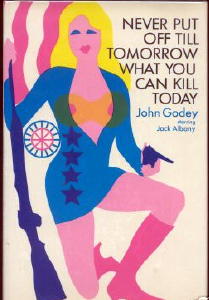|
JOHN GODEY: IN MEMORIAM (1912-2006) by
Steve Lewis
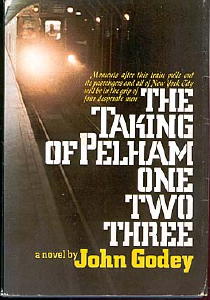 Known far better to mystery readers as his more famous byline, John Godey, author Morton Freedgood died Sunday, April16th, at the age of 93. Some of the information that follows comes from his Associated Press obituary dated April 21st of this year; other data was obtained from: Allen J. Hubin, Crime Fiction IV
Bill Contento’s FictionMags Index www.amazon.com www.imdb.com The New York Times All Media Guide. In some places the details below are sketchy, and as more is learned, additions and corrections will be made to this page. (Thanks to Victor Berch and his diligent research into the musty archives of the Internet, much of the information which follows has been greatly added to and improved from the original version of this article.) Freedgood was born in Brooklyn, went to City College of New York in the 1930s, and served in the army during World War II. As M. Eliot Freedgood, one early article for the New York Times (June 27, 1937) was entitled “Ribald Row’s Pioneers,” giving readers some of the history of New York City’s 52nd Street in conjunction with Walter Wanger’s movie extravaganza of the same name, 52nd STREET. On July 12, 1942, “Let Me Tell You About Manhattan,” a radio play written by Morton Freedgood, was performed as a Columbia Workshop presentation on CBS. (On the same evening, but an hour earlier on the Mutual network, was the first episode of a new series called Murder Clinic. An adaptation of a Philip Trent story by E. C. Bentley, “The Ordinary Hairpins,” could have been heard, if you were there and had your radio turned on.) After the war, Freedgood began working full time in the motion picture industry in New York, holding public relations and publicity posts for United Artists, 20th Century Fox, Paramount and other companies for several years, after which he decided to turn to writing full time. Laura Freedgood, his daughter, is quoted in his obituary as saying that he took the pen name “John Godey” from the name of a well-known 19th century ladies’ magazine, Godey’s Lady’s Book, to help distinguish his crime fiction from his more serious work. Godey’s earliest work under this pen name consisted of articles and short stories published in Cosmopolitan, Collier’s, Esquire and other magazines. Of his shorter fiction, the following has been located and indexed so far: “The Pretenders” Good Housekeeping, February 1947. “The Wrong Way to Win a War” Collier’s, April 11, 1953. “The Lovers” Manhunt, October 1956. “It’s All Quite Painless” Alfred Hitchcock, August 1957. “The Fifth House” Cosmopolitan, June 1958. [The basis for the novel of the same name. See below.] In similar fashion to the one that appeared in 1937, the following newspaper articles from the New York Times also center on the movie business, the bylines being either as by M. E. Freedgood, or by Morton Elliott Freedgood. In all likelihood, they are but a sampling of the journalistic pieces which he wrote during the 1950s: July 9, 1950 “Maugham on ‘Trio.’” Background on the movie of that title, as Somerset Maugham comes to town. October 15, 1950. “Big Man What Now?” Charlton Heston’s early days in Hollywood. July 9, 1951. “Movies: By the Dawn’s Early Light.” Filming the movie ANYTHING CAN HAPPEN. November 18, 1951. “Presenting One Detective’s Story.” A long profile of the actor Horace McMahon. December 11, 1955. “‘Alexander’s’ Researcher.” Behind the scenes while filming ALEXANDER THE GREAT. One contemporary novel appeared under Freedgood’s own name: The Wall-t0-Wall Trap, Simon & Schuster, hc, 1957. Macfadden 60-185, pb, 1964. 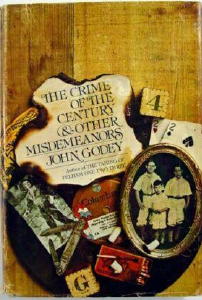 Several years earlier Morton and his brother Stanley wrote one book, a work of historical fiction, under the combined pseudonym of “Stanley Morton.” Yankee Trader. Sheridan House, hc, 1947. Pyramid Giant G54, pb, 1952. [Comment: The somewhat lurid paperback edition is described as an adventure novel about a lusty sea captain dealing heavily with the slave marts of Africa. Details about the hardcover are more restrained: “Set amongst the Yankee privateers in New England in the wars of the late 18th century.”] During the 1970s, Stanley Freedgood, who was born in 1915 and died in 1994, was the Deputy Commerce Commissioner for Public Information for the state of New York, up in Albany. The book whose cover you see to the left is Morton Freedgood’s autobiography, written as by John Godey. Its title is The Crime of the Century and Other Misdemeanors: Recollections of Boyhood (G. P. Putnam’s Sons, hc, 1974), and it consists of his memoirs of what life was like in Manhattan’s upper east side in the 1920s. Quite irrelevant, but interesting nonetheless, is an illustrated article in The New York Times (April 24, 1977) about Lillian Freedgood, the author’s wife, and her professional avocation of avocado pit sculpture. BIBLIOGRAPHY OF CRIME FICTION  The Gun and Mr. Smith. Doubleday/Crime Club, hc, 1947. Two Complete Detective Books, September 1948. [Paired with THOMAS BLACK The Pinball Murders.] Berkley 02376, pb, 1973. Coronet-UK, pb, 1976. The Blue Hour. Doubleday/Crime Club, hc, 1948. Two Complete Detective Books, November 1948. [Paired with D. B. OLSEN Gallows for the Groom.] T. V. Boardman-UK #65, pb, 1949. Bestseller Mystery B180, as Killer at His Back, pb, 1955. [abridged] Berkley 02515, pb, February 1974. Tandem-UK, as The Next to Die, pb, 1975. The Man in Question. Doubleday/Crime Club, hc, 1951. [Peter Manning spy novel.] T. V. Boardman-UK, hc, 1953. Bestseller Mystery B188, as The Blonde Betrayer, pb, 1955. Berkley 02495, pb, January 1974. [NOTE: The covers of the this edition were switched with those of KEITH LAUMER Night of Delusions, a science-fiction novel published by Berkley the same month.] This Year’s Death. Doubleday/Crime Club, hc, 1953. T. V. Boardman-UK, hc, 1953. Two Complete Detective Books, Winter 1953-54. [Paired with FRANK KANE Poisons Unknown.] Bestseller Mystery B174, pb, Berkley 02538, pb, 1974. Tandem-UK, pb, 1975. The Clay Assassin. T. V. Boardman-UK, hc, 1959. [Bloodhound Mystery #275.] Berkley 02411, pb, 1973. 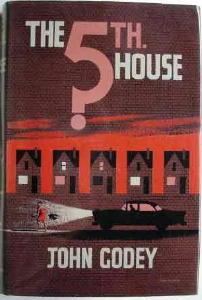 Coronet-UK, pb, 1976. Coronet-UK, pb, 1976.The Fifth House. T. V. Boardman-UK, hc, 1960. [Bloodhound Mystery #304.] Berkley 02399, pbo, 1973. Tandem-UK, pb, 1975. -Expanded from story in Cosmopolitan, June 1958. The Reluctant Assassin. Robert Hale Ltd-UK, hc, 1966. Simon & Schuster, as A Thrill a Minute with Jack Albany, hc, 1967. [Jack Albany is a television actor who is mistaken for a hit man.] Gold Medal d1956, with US title, 1968. [Notable cover art by Jack Davis.] Fawcett Gold Medal M2801, with US title, 1973. Never Put Off Till Tomorrow What You Can Kill Today. Random House, hc, 1970. [Jack Albany] The Three Worlds of Johnny Handsome. Random House, hc, April 1972. Mystery Guild, book club edition, July 1972. Hodder & Stoughton-UK, hc, 1973. Warner Paperback Library 75-165, pb,1973. The Taking of Pelham One Two Three. G. P. Putnam’s Sons, hc, 1973. Hodder & Stoughton-UK, hc, 1973. Dell 8495, pb, February 1974. Coronet-UK, pb, 1974 Dell 18495, pb, April 1982. The Talisman. G. P. Putnam’s Sons, hc, 1976. W. H. Allen-UK, hc, 1977. Berkley 03492, pb, September 1977. 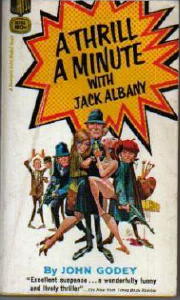 The Snake. G. P. Putnam’s Sons, hc, 1978. New English Library-UK, hc, 1978. Berkley 04163, pb, 1979. New English Library-UK, pb, 1979. Nella. Delacorte Press, hc, March 1981. Severn House-UK, hc, 1982. Dell 16111. pb, May 1982. Sphere-UK, pb, 1982. Fatal Beauty. Atheneum, hc, August 1984. Methuen-UK, hc, 1985. Warner 32908, pb, October 1985. Methuen-UK, pb, 1986. NOTE: For a partial list of John Godey’s books translated into other languages, go here. FILMS (Movies and TV) - In spite of an earlier movie version of one of his books, Godey’s greatest commercial success did not begin until The Taking of Pelham One Two Three was filmed. Written in the era when airline hijackings were common, it is about four men who take over a New York City subway train and hold the passengers for a million dollars in ransom. Film rights were sold, it is reported, even before the book was published. City officials were concerned that the film would induce “copycat” events, but this does not seem to have happened. Never a Dull Moment. Based on The Reluctant Assassin [A Thrill a Minute with Jack Albany], Walt Disney, 1968. Starring Dick Van Dyke, Edward G. Robinson, Dorothy Provine. The Taking of Pelham One Two Three. United Artists, 1974. Starring Walter Matthau, Robert Shaw, Martin Balsam and many others. Disneyland: “Never a Dull Moment”. Based on The Reluctant Assassin [A Thrill a Minute with Jack Albany]. TV episode, March 4, 1979. (Season 25, Episode 16). Johnny Handsome. Based on The Three Worlds of Johnny Handsome, TriStar, 1989. Starring Mickey Rourke, Ellen Barkin, Elizabeth McGovern. The Taking of Pelham One Two Three. Made-for-TV movie, 1998.
I’ll just say it. THE TAKING OF PELHAM ONE TWO THREE is my favorite movie of all time. Are there better films? Absolutely. But you won’t find many that are as purely entertaining, combining an ingenious premise with crackerjack pacing and a sensibility that’s all New York. John Godey’s novel about the hijacking of a subway train must have triggered a few calls to the tourism office in 1973. New York was in the process of what’s now known as “rebranding,” mothballing its ill-advised ‘Fun City’ nickname in favor of ‘The Big Apple.’ 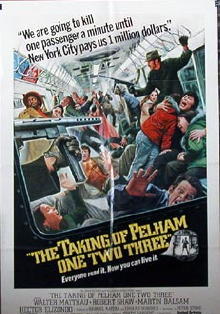 But Hollywood knew a sure-fire premise when it heard one, and rushed an adaptation into theaters the following year. Directed by Joseph Sargent and featuring a script by Peter Stone (CHARADE), the film is a perfect balance of suspense and dark humor. The battle of wits between the working-class heroes of the transit system (in particular the pitch-perfect Walter Matthau) and the quartet of truly ruthless gunmen led by Robert Shaw is relentless; it’s the rare thriller in which good guys and bad guys are equally matched. What sets the film apart is its meticulous construction – seemingly insignificant details pay off in unexpected ways – and its take on urban life. Stone’s dialogue captures New York in all its cynical glory. Consider the scene in which the mayor weighs whether he should meet the ransom demand Hizzoner’s Wife: I know a million dollars sounds like a lot of money. Just think what you’re going to get in return. Hizzoner: What? Hizzoner’s Wife: Eighteen sure votes. On top of that, you have David Shire’s driving, percussive score and one of the great closing shots, wrapping up the story with deadpan understatement. What’s not to love? An entire generation of filmmakers have acknowledged PELHAM’s influence, like the Academy-Award winning writer Christopher McQuarrie (THE USUAL SUSPECTS) and Quentin Tarantino; the thieves in RESERVOIR DOGS use colors as aliases in tribute to Shaw’s crew. But perhaps the greatest compliment paid to the movie was belatedly made by the city itself. The New York Transit Authority refused to cooperate with the production in 1974. Visit the authority’s museum in Brooklyn and you’ll find a sizeable exhibit devoted to movies shot in the city’s subways – in which PELHAM receives pride of place. As for the 1998 made-for-TV remake, my respect for the original is so great that I refused to watch it. 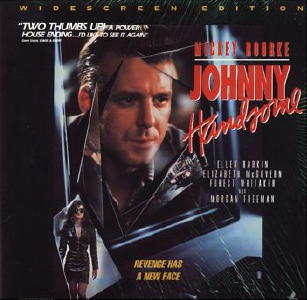 Godey’s 1972 novel The Three Worlds of Johnny Handsome
is built around another movie-ready concept. The title character
is a career criminal whose face has been deformed since birth. He
receives extensive plastic surgery as part of a prison experiment
intended to rehabilitate him. Once on the outside Johnny tries to
go straight, but he also realizes that his new looks will allow him to
settle old scores. Godey’s 1972 novel The Three Worlds of Johnny Handsome
is built around another movie-ready concept. The title character
is a career criminal whose face has been deformed since birth. He
receives extensive plastic surgery as part of a prison experiment
intended to rehabilitate him. Once on the outside Johnny tries to
go straight, but he also realizes that his new looks will allow him to
settle old scores.The underrated 1989 film adaptation shortened the title to JOHNNY HANDSOME. Mickey Rourke plays the lead in a performance that prefigures his acclaimed work in 2005’s SIN CITY. Director Walter Hill stages the action with his customary skill, and steeps the film in sultry Louisiana atmosphere. The movie’s greatest pleasures come from its supporting cast. Detective Morgan Freeman and surgeon Forest Whitaker engage in off-kilter nature-versus-nurture debates. And no one spits out the word ‘geek’ like Ellen Barkin as a white trash gun moll in a leather miniskirt. Walt Disney filmed Godey’s comic novel The Reluctant Assassin (also known as A Thrill a Minute with Jack Albany) under the title NEVER A DULL MOMENT in 1968. As a Godey fan I made it a point to watch the movie when it surfaced on The Disney Channel a few years ago in the wee hours of the morning. Apparently it was intended as a sleep aid, because I only lasted a few minutes. Those are the only Godey adaptations so far. Considering his flair for what Hollywood calls “high concept ideas,” I’m sure more will follow. Take his 1978 novel The Snake, for instance, about a deadly black mamba on the loose in New York’s Central Park. I can see the poster now. In fact, it looks a lot like the book’s cover. Bengali Pelhyam ekta teis. Tr. by Saurin Ray. Calcutta:Chirayat, 1977. Transl. of The Taking of Pelham One Two Three. Catalan Els tres mons de Johnny Benplantet. Tr. by Mireia Porta i Arnau. Barcelona: Ediciones 62, 1993. Transl. of The Three Worlds of Johnny Handsome. Danish Attentat i ler. Tr. by Erna Frentz Sørensen. København: Merved, 1981. Transl. of The Clay Assassin. Slangen. Tr. by Mogen Boisen. København: Lademann, 1980. Transl. of The Snake. Same, except published 1989. Togkaring. Tr. by Mogen Boisen. København: Lademann, 1988. Transl. of The Taking of Pelham One Two Three. Dutch De Slang. Tr. by M. Slagt-Prins. Antwerpen: A. W. Bruna en Zoon, 1980 Transl. of The Snake. Same, except published in Utrecht: Bruna, 1991. French Frissons garantis. Tr. by Oscar Ollivier. Paris: Gallimard, 1981 Transl. of A Thrill a Minute with Jack Albany. Le rôdeur de Central Park. Tr. by Monique Lebailly. Paris: Le Table ronde, 1980. Transl. of The Snake. Same, except published in Lausanne: Ex Libris, 1980 and in Zurich: Ex Libris, 1980. German Abfahrt Pelham 1 Uhr 23. Tr. by Wolf Bergner. Bern: Scherz, 1980. Transl. of The Taking of Pelham One Two Three. Same, except published in München: Scherz, 1980. Der tödliche Biss. Tr. by Christiane Kashin. Frankfurt am Main, Berlin: Ullstein, 1986. Transl. of The Snake. Hungarian Hajsza a föld alatt. Tr. by Judit Zilahi. Budapest: Magveto, 1989. Transl. of The Taking of Pelham One Two Three. Japanese Fukushû no futatsu no kao. Tr. by Sawa Kawa Susu-mu. Tokyo: Hayakawa syobo, 1980. Transl. of The Three Worlds of Johnny Handsome. Manhattan yûwaku jiken. Tr. by Akira Saki. Tokyo: Kôdansha, 1983. Transl. of Nella. Sabuwei panikku. Tr. by Murakami Hiroki. Tokyo: Hayakawa syobo, 1979 Transl. of The Taking of Pelham One Two Three. Za suneiku. Tr. by Akira Saki. Tokyo: Kôdansha, 1980 Transl. of The Snake. Malayan Mun Swe Phwe Phwe Thwe Yeye. Tr. by Soe Thein. Rangoon: Htarwara Sarpay, 1984. Transl. of The Snake. Norwegian Hauk over hauk. Tr. by Anne Haugen. Oslo: Bladkompaniet, 1985. Transl. of Fatal Beauty. Portuguese O sequestro do metro. Tr. by Agahta Aubsberg. São Paolo: Abril Cultural, 1984. Transl. of The Taking of Pelham One Two Three. Spanish Johnny el guapo. Tr. by Jesús de la Torre. Barcelona: Plaza & Janés, 1990 Transl. of The Three Worlds of Johnny Handsome. Pelham, uno dos, tres. Tr. by José Ferer Aleu. Barcelona: Plaza & Janés, 1980. Transl. of The Taking of Pelham One Two Three. Same, except published in 1984. La pistola. y Mr. Smith. Tr. by José Martinez Monasterio. Plaza & Janés, 1979. Transl. of The Gun and Mr. Smith. La serpiente. Tr. by Hernán Sabate. Mexico: Roca, 1987. Transl. of The Snake. El talismán. Tr. by Lorenzo Cortina, Barcelona: Plaza & Janés, 1979. Transl. of The Talisman. Swedish Ormen. Tr. by Jan Järnebrand. Höganas: Bra böcker, 1978. Transl. of The Snake. Same, except published Höganas: Läsabra, 1978. Nella. Tr. by Jan Järnebrand. Höganas, Bra böcker, 1985. Transl. of Nella. YOUR COMMENTS ARE WELCOME. |
